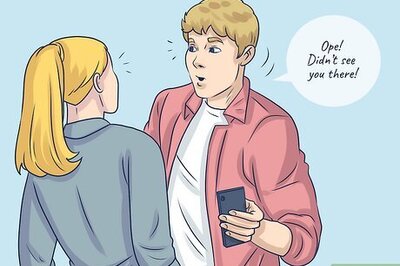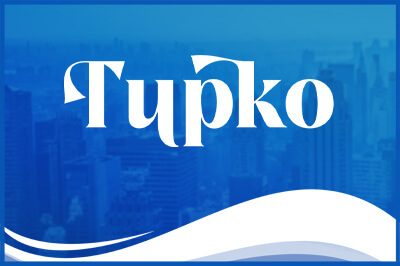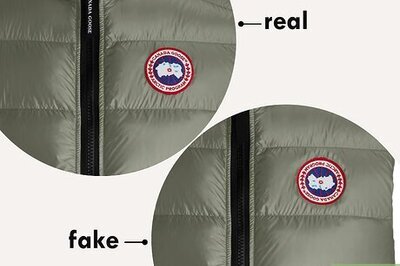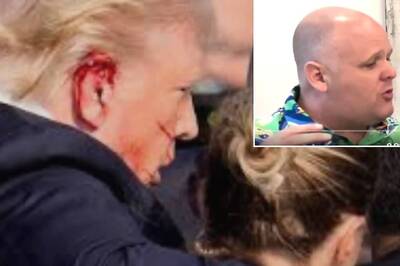
views
What is haint blue?
Haint blue is a pale blue-green paint color that’s often used on porch ceilings in the South. Haint blue comes in multiple shades, with each resembling a different shade of natural blue, like sky blue and ocean blue. The use of haint blue goes back to the Gullah Geechee people, some of whom believed the shade warded off mischievous spirits called haints. The color has been used by Gullah people all throughout the South, particularly in Charleston, South Carolina, and Savannah, Georgia. Haint blue has historically been used to protect homes from haints, birds, and bugs. The word “haint” is derived from the word “haunt,” which refers to ghosts or spirits.
Cultural Significance of Haint Blue
Spiritually, haint blue helps protect the home from haints (scary, chaotic spirits). According to Gullah Geechee legend, the color haint blue helped repel haints from the home, as it resembled the color of the ocean (which ghosts were unable to cross) and the sky (which ghosts pass right through). To protect the home, the ceilings of porches, window frames, and other outdoor parts of the house were painted haint blue, spreading the color throughout the Southern U.S.
Culturally, the indigo crop is linked to slavery, and haint blue is linked to the Gullah people. Historically, indigo was a cash crop that was cultivated during the era of slavery in the United States. Although the crop nearly disappeared after the invention of synthetic blue dyes, indigo remained culturally relevant to Black people. Once it was adopted by the Gullah people for the creation of haint blue, it became a cultural strongpoint for them, and is still linked to them today.
Why do people use haint blue?
It’s believed to repel haints. Historically, haint blue has been thought to repel haints due to its resemblance to water, which haints are unable to cross. Some believe the paint’s repelling properties are because of the shade’s resemblance to sky blue, which confuses haints and causes them to pass through the ceiling, avoiding the inside of the house.
It’s also thought to repel birds and bugs. Aside from haints, haint blue is also thought to repel birds and bugs because of its resemblance to natural shades of blue. Like the haint legend, haint blue is thought to repel bugs and birds because they believe it’s the sky. Although there’s no scientific proof for this link, many still swear by it.
Some people simply admire the shades of haint blue. For some, haint blue is just a pretty color that goes well with their house. Nothing more, nothing less. They may not be aware of the color’s cultural significance, and simply enjoy the color because it’s a soft blue hue of the outside world.
Shades of Haint Blue
Benjamin Moore Palladian Blue Benjamin Moore’s Palladian Blue shade of haint blue takes on a soft blue hue with a noticeable touch of green. Lightly murky with strong blue undertones, this shade resembles the soft shades that reflect off of lakes. Goes best with: Brown & cinnamon shades.
Sherwin-Williams Atmospheric Sherwin-Williams’ Atmospheric shade of haint blue lives up to its name, drawing on baby blue hues to form a color reminiscent of the sky. Bright blue with subtle shades of grey, the atmospheric shade of haint blue is perfect if you’re trying to bring shades of the sky to your front porch. Goes best with: Yellow & warm gray shades.
Sherwin-Williams Rainwashed Sherwin-Williams’ Rainwashed shade of haint-blue resembles more of an aqua-green and grey mix rather than a light shade of blue, drawing hints of rainwater in its hue. It’s perfectly reminiscent of a rainy day, making it a great choice if you’re a fan of the gloomier shades. Goes best with: Pewter & khaki shades.
Benjamin Moore Woodlawn Blue The Woodlawn Blue shade of haint blue by Benjamin Moore is a soft, even mix of blue and green that highlights the blue with green undertones. This color is also reminiscent of the ocean, making it a great choice if you want to see the sea when you chill out on your porch. Goes best with: Woody brown & maroon shades.
Benjamin Moore Harbor Haze Benjamin Moore’s Harbor Haze shade also lives up to its name, with the blue base resembling the water of the harbor and the soft green-grey undertones resembling the haze. It’s the perfect mix between gloomy and vibrant shades! Goes best with: Dark grey, deep maroon, blue, and orange shades.
Sherwin-Williams Pool Blue The Pool Blue shade of haint blue by Sherwin-Williams is a bright one, resembling the crystal blue waters of a swimming pool on a summer day. It has an extremely subtle hint of green that helps accentuate the blue, making it a great choice if you’re looking for a vibrant look. Goes best with: Tangerine orange & brown shades.
Farrow & Ball Dix Blue The Dix Blue shade of haint blue is a vintage shade from Farrow & Ball, and that shows in its hue. While the blue and green shades work together to form an eye-catching color, that color is muted, making it a great choice if you’re looking for a subtle throwback look. Goes best with: Gold, dark brown, maroon, and deep pink shades.
Olympic Niagara Falls Olympic’s Niagara Falls shade of haint blue takes on a strong baby blue hue. This shade is pleasant on the eye, resembling the sky blue color that shines during a cloudless sunny day. To replicate the bright look of the sunny sky on your porch, opt for Olympic’s Niagara Falls shade. Goes best with: Deep blue, tan, and cream-colored shades.
Farrow & Ball Borrowed Light Farrow & Ball’s Borrowed Light shade is an extremely bright shade of haint blue with no hints of green. Instead, it's made of a bright base of white with subtle hints of blue. Borrowed Light lives up to its name, too, looking more like morning sunlight in a paint can than anything else. Goes best with: Ivory & cream shades
Olympic Aqua Fiesta Olympic’s Aqua Fiesta shade of haint blue is reminiscent of aquariums, taking on a deep, vibrant aqua-green look. Whether you’re into the tropical, aquatic look or you want a deep, watery color to complement your porch, Olympic Aqua Fiesta is right up your alley. Goes best with: White, cream, and eggshell shades.
Is haint blue offensive?
Haint blue itself isn’t offensive, but the history behind it may be sensitive for some. Painting your porch ceiling haint blue isn’t offensive in itself, as haint blue is a widely used color. But, there are some people who may be sensitive about your use of haint blue, whether it’s because you aren’t connected to the Gullah culture or because they are Gullah themselves and hold the tradition to heart. If someone does take offense, apologize and have a conversation about haint blue and its connection to the Gullah people. If they aren’t receptive to a conversation, kindly explain that you didn’t mean to offend them, apologize for offending them, and then exit the conversation.




















Comments
0 comment